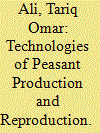| Srl | Item |
| 1 |
ID:
155916


|
|
|
|
|
| Summary/Abstract |
During the 1920s, a new genre of didactic poems prescribing the proper Islamic practice of everyday peasant lives were published out of printing presses in deltaic, eastern Bengal's small towns. This article argues that these printed poems constituted a discourse of agrarian Islam that prescribed reforms in peasant material life—work, commerce, consumption, attire, hairstyle, and patriarchal authority—as a means of ensuring the viability of peasants’ market-based livelihoods. The article examines the emergence of a small-town Muslim intelligentsia that authored and financed the publications of these poems out of the Bengal delta's small-town printing industry. Eschewing communalism as an analytical frame in understanding South Asian Muslim identities, this article argues that Bengali peasant Muslim subjectivity was located in peasant engagements with agrarian markets. Agrarian Islamic texts urged Muslim cultivators to be good Muslims and good peasants, by working hard, reducing consumption, and balancing household budgets.
|
|
|
|
|
|
|
|
|
|
|
|
|
|
|
|
| 2 |
ID:
167089


|
|
|
|
|
| Summary/Abstract |
In December 1959, the newly-constituted Pakistan Academy of Rural Development received permission to create a ‘laboratory’, that is, to conduct experiments in rural development upon peasants in Comilla, East Pakistan. This paper explores the enmeshing of post-colonial state formation and Cold War American development practices through an examination of how the Academy’s built environments, everyday practices and discourses were shaped by agricultural and contraceptive technologies. It examines how the Academy transformed a Gandhian ashram into a display and distribution centre for these technologies, and how technologies informed the Academy’s discourses on peasant religiosity and shaped peasant understandings of state and empire.
|
|
|
|
|
|
|
|
|
|
|
|
|
|
|
|